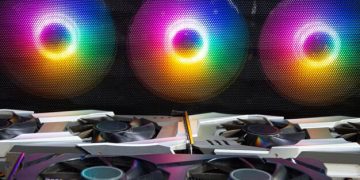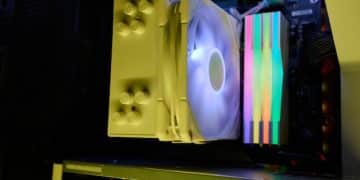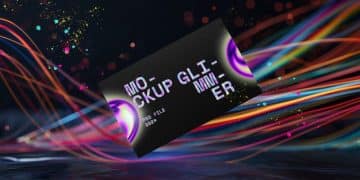Is Your CPU Bottlenecking Gaming? Find Out & Upgrade 2025
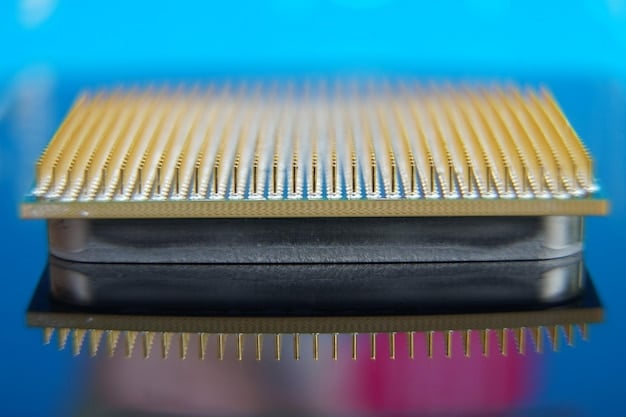
A CPU bottleneck in gaming occurs when your processor cannot keep up with the demands placed on it by your graphics card, leading to lower frame rates and unstable performance, necessitating an upgrade for optimal gaming experience in 2025.
In the dynamic world of PC gaming, achieving optimal performance is a continuous quest. As graphics cards become increasingly powerful, a critical question emerges for many enthusiasts: Is Your CPU Bottlenecking Your Gaming? Find Out and Upgrade in 2025. This article delves into how to identify a CPU bottleneck and outlines the steps to take for a seamless upgrade in the upcoming year.
Understanding CPU Bottlenecks in Gaming
A CPU bottleneck happens when your central processing unit (CPU) limits the performance of other components, most notably your graphics processing unit (GPU). This means your powerful GPU isn’t able to render frames at its full potential because the CPU isn’t feeding it data fast enough. It’s like having a super-fast highway but only a single-lane exit; traffic can’t flow efficiently.
Identifying a bottleneck is crucial because it directly impacts your gaming experience, leading to choppy frame rates, stuttering, and inconsistent performance, even if you’ve invested heavily in a high-end graphics card. Gamers often attribute poor performance solely to the GPU, overlooking the CPU’s vital role in synchronizing and processing game logic, AI, physics, and drawing calls.
Signs of a CPU Bottleneck
Recognizing the symptoms of a CPU bottleneck is the first step toward resolution. These signs can be subtle at times, but with careful observation, they become apparent. It’s not always about low frame rates; sometimes it’s about inconsistent frame delivery.
- Low GPU Utilization: If your GPU usage typically hovers around 60-70% or less while your CPU usage is consistently near 100% in demanding games, you likely have a CPU bottleneck.
- Stuttering and Frame Rate Drops: Experiencing sudden, noticeable drops in frame rates, especially in CPU-intensive scenarios like large open-world areas or crowded online lobbies, is a strong indicator.
- Unstable Frame Times: While your average frame rate might seem acceptable, inconsistent frame times (the time it takes to render each frame) manifest as a choppy, non-fluent visual experience.
- CPU Running at 100% Constantly: If your CPU is constantly maxed out during gaming, regardless of the game’s graphical settings, it’s struggling to keep up.
Understanding these signs is foundational. Many gamers mistakenly upgrade their GPU only to find little improvement, as the underlying issue remains with their central processing unit. Proactive monitoring of component usage is the most reliable way to diagnose this issue.
The impact of a CPU bottleneck extends beyond just frames per second. It can severely limit the fluidity of gameplay, making fast-paced action feel sluggish and unresponsive. Modern games, with their complex open-world environments, intricate AI, and advanced physics, demand more from CPUs than ever before. Therefore, a balanced system, where both the CPU and GPU are optimized to work in harmony, is essential for a premium gaming experience.
Diagnostic Tools and Methods
To accurately determine if your CPU is bottlenecking your gaming, you need reliable tools and methods for real-time monitoring. Simply observing performance might give you a hint, but hard data provides definitive answers. These tools offer insights into component utilization, temperatures, and clock speeds, painting a clear picture of your system’s health and performance bottlenecks.
Several software applications are designed specifically for this purpose, ranging from simple overlays to comprehensive system monitors. Utilizing these tools during your gaming sessions will gather the necessary data to make an informed decision about potential upgrades. The data collected should include CPU usage, GPU usage, frame rates, and temperatures.
Software for Monitoring
- MSI Afterburner: This is arguably the most popular and versatile tool. It allows you to monitor GPU and CPU usage, temperatures, clock speeds, and frame rates in real-time, often displayed as an on-screen overlay during gameplay. It also offers powerful GPU overclocking capabilities, though for bottleneck identification, its monitoring suite is key.
- HWMonitor: A simpler, lightweight tool that provides detailed information about your system’s sensors, including voltages, temperatures, fan speeds, and utilization rates for CPU, GPU, and other components. While it lacks an in-game overlay, it’s excellent for background logging.
- CapFrameX: Ideal for more advanced users, CapFrameX provides detailed frame time analysis, which is critical for identifying micro-stuttering and uneven frame delivery, often a tell-tale sign of a CPU bottleneck. It captures extensive data during gameplay sessions.
When using these tools, pay close attention to the utilization percentages of your CPU and GPU. An ideal scenario sees both components nearing 90-100% utilization in demanding scenarios, indicating a balanced system. If your GPU utilization is significantly lower than your CPU’s, and your CPU is consistently maxed out, a bottleneck is highly probable.
Practical Diagnostic Steps
Beyond just looking at numbers, performing specific tests can further confirm the presence of a bottleneck. These steps involve adjusting game settings to manipulate the load on your CPU and GPU, observing how your system responds.
Run a demanding game (ideally one known for being CPU-intensive) and monitor your CPU and GPU usage. First, play at your desired resolution and settings. Note the frame rates and component utilization. Then, lower the graphical settings significantly (e.g., reduce texture quality, shadows, anti-aliasing) while keeping the resolution the same. If your frame rate doesn’t significantly increase despite the reduced GPU load, and your CPU utilization remains high, your CPU is likely the limiting factor. Conversely, if dropping settings leads to a substantial FPS boost and your GPU utilization was high, your GPU might have been the bottleneck, or the system was balanced. The key is to isolate the component preventing higher performance. This method helps differentiate between a GPU and CPU limitation.
Another method involves increasing the resolution or graphical settings to maximize GPU load. If your CPU usage drops while your GPU usage maximises and your frame rates remain relatively stable, it indicates your GPU is now the bottleneck, and previously, the CPU might have been less constrained. This back-and-forth testing helps pinpoint the precise weak link in your gaming chain, ensuring any future upgrades are targeted and effective.
Factors Influencing CPU Performance in Gaming

The performance of a CPU in gaming isn’t solely dependent on its clock speed. A multitude of factors contribute to how effectively a processor handles game workloads. Understanding these elements helps in appreciating why specific CPUs perform better than others, particularly in gaming scenarios.
Modern games leverage multiple CPU cores, high clock speeds, and efficient architectures. It’s a complex interplay where a well-rounded processor excels. Single-core performance, while still important for some older or less optimized game engines, has been largely superseded by the need for strong multi-core capabilities, especially in open-world titles and multiplayer experiences.
Core Count and Clock Speed
Historically, clock speed (GHz) was the primary metric for CPU performance. While still relevant, the rise of multi-core processors has shifted the focus. Many modern games are designed to utilize multiple cores, distributing tasks across them to improve parallel processing.
- Core Count: More cores allow a CPU to handle more tasks simultaneously. For gaming, a CPU with 6 to 8 cores is often considered the sweet spot for balance between gaming performance and cost-effectiveness. While some games primarily rely on 4-6 cores, having more can benefit background applications and future-proof your system.
- Clock Speed: High clock speeds still mean faster processing within each core. For gaming, a high single-core turbo clock speed is highly beneficial, as some game engines still rely heavily on the performance of a few strong threads. This is where the balance comes in: enough cores for modern game parallelism, coupled with high individual core speeds.
The synergy between core count and clock speed is vital. A CPU with many cores but low clock speeds might struggle with games that only utilize a few threads, while a high-clock-speed dual-core CPU would falter with multi-threaded games. The optimal balance ensures smooth gameplay across a wide range of titles.
Cache Size and Architecture
Beyond cores and clock speeds, a CPU’s internal architecture and cache memory play a significant role in its gaming prowess. These often-overlooked aspects can provide considerable performance advantages.
Cache: Cache memory acts as a very fast data storage located directly on the CPU. It stores frequently accessed data, allowing the CPU to retrieve it much faster than from main system memory (RAM). Larger and more efficient cache sizes (L1, L2, L3) significantly reduce latency and speed up data processing, directly translating to better frame rates and smoother performance in games. Modern CPUs often feature large L3 caches, which are particularly impactful for gaming.
Architecture: The underlying design of the CPU (its microarchitecture) determines how efficiently it processes instructions. A newer, more refined architecture (like AMD’s Zen series or Intel’s Core architectures) will generally perform better even at similar clock speeds or core counts compared to older architectures. Architectural improvements often bring better Instruction Per Cycle (IPC), meaning more work gets done per clock cycle. This is why a new generation CPU often outperforms an older one, even if the raw specifications seem similar. These advancements contribute to overall system responsiveness and gaming fluidity.
Factors like the manufacturing process (e.g., 7nm, 5nm) also influence performance by allowing for denser, more power-efficient designs, leading to higher clock speeds and better thermal management. In essence, a strong gaming CPU isn’t just about high numbers; it’s about a harmonious blend of cores, clock speed, ample cache, and a cutting-edge, efficient architecture.
Choosing the Right CPU Upgrade for 2025
Upgrading your CPU is a significant decision that involves more than just picking the fastest processor. It requires careful consideration of compatibility, future-proofing, and the overall balance of your system. As we approach 2025, the landscape of CPU technology continues to evolve, offering increasingly powerful and efficient options for gamers.
The goal isn’t just to eliminate the current bottleneck, but to ensure your system performs optimally for years to come without requiring another immediate upgrade. This involves looking at the current offerings from both Intel and AMD, considering their respective platforms, and evaluating your specific gaming needs.
Intel vs. AMD: Which Platform?
The choice between Intel and AMD largely dictates your motherboard and, to some extent, your upgrade path. Both manufacturers offer compelling processors, each with their own strengths.
- Intel: Traditionally known for strong single-core performance, which benefits many games. Intel’s recent generations have significantly ramped up core counts and introduced hybrid architectures (Performance-cores and Efficiency-cores) for improved multi-tasking and efficiency. Their platforms often feature high-speed memory support and robust PCIe lanes.
- AMD: Gained significant market share with its Ryzen processors, offering excellent multi-core performance at competitive prices. AMD’s processors often come with more cache, which can be advantageous in gaming. Their platforms (like AM4 and the newer AM5) have historically offered better upgrade paths within the same socket, potentially saving on motherboard costs for future upgrades.
For 2025, both companies are expected to continue pushing boundaries. The choice often comes down to specific price-to-performance ratios at different tiers, and whether you prioritize raw single-core speed or overall multi-core prowess. Researching recent benchmarks for the games you play is essential when making this decision.
Considerations for a Balanced System
A powerful CPU alone won’t guarantee an exceptional gaming experience. A truly balanced system integrates the CPU with other components to ensure none act as a limiting factor. This holistic approach prevents new bottlenecks from emerging after your CPU upgrade.
Motherboard Compatibility: Your new CPU must be compatible with your motherboard’s socket (e.g., Intel LGA1700, AMD AM5). A new CPU often means a new motherboard, which adds to the cost and complexity of the upgrade. Ensure your chosen motherboard supports the CPU, RAM type (DDR4 or DDR5), and PCIe generation (e.g., PCIe 5.0 for future GPUs) you intend to use.
RAM Speed and Capacity: Modern CPUs, especially AMD Ryzen, benefit significantly from faster RAM speeds (e.g., DDR5 6000MHz+). Aim for at least 16GB of RAM (32GB is increasingly becoming the standard for high-end gaming in 2025) running at optimal speeds. Fast RAM feeds the CPU data more quickly, reducing potential memory-related bottlenecks.
Cooling Solution: A more powerful CPU generates more heat. Ensure you have an adequate CPU cooler (air or liquid) to prevent thermal throttling, which can severely diminish performance. Don’t skimp on cooling; it’s vital for maintaining peak performance during long gaming sessions.
Power Supply Unit (PSU): A new, more powerful CPU, especially if coupled with a high-end GPU, will demand more power. Verify your PSU has sufficient wattage and the necessary connectors to support your upgraded components. Underpowered PSUs can lead to system instability or even hardware damage.
By considering all these elements in conjunction with your CPU choice, you build a robust and future-proof gaming rig that maximizes performance across the board. An upgrade should be a strategic investment, not just a quick fix.
The Upgrade Process: Step-by-Step
Upgrading your CPU can seem daunting, but by following a systematic approach, you can ensure a smooth and successful transition. Preparation is key, as is taking your time and being careful with delicate components. This guide assumes you’ve already chosen your new CPU and, if necessary, a new motherboard and RAM.
Pre-Upgrade Preparations
Before you even open your PC case, there are several crucial steps to take. These preparations prevent data loss, ensure system stability, and simplify the installation process.
- Backup Important Data: While a CPU upgrade rarely directly affects your data, it’s always prudent to back up critical files. This safeguard protects you against any unforeseen issues during the upgrade or subsequent software reinstallation.
- Gather Tools: You’ll need a Phillips-head screwdriver, zip ties for cable management, and thermal paste (unless your new cooler comes with it pre-applied). Having a clean, well-lit workspace is also recommended.
- Update BIOS/UEFI (if keeping current motherboard): If you’re only upgrading your CPU but keeping your existing motherboard, check the motherboard manufacturer’s website to ensure your current BIOS/UEFI version supports the new CPU. If not, update it BEFORE installing the new CPU. This is a common oversight that leads to initial boot failures.
- Discharge Static Electricity: Before touching any internal components, ground yourself to discharge static electricity. This can be done by touching a grounded metal object (like a radiator) or by using an anti-static wrist strap. Static discharge can damage sensitive computer components.
Taking these preliminary steps seriously will save you time and potential headaches down the line. A rushed or unprepared upgrade often leads to troubleshooting issues that could have been avoided.
Physical Installation of CPU and Components
The physical installation requires precision and care. Different CPU sockets (Intel LGA, AMD AM) have slightly different installation procedures, but the general principles remain the same.
Remove Old Components: First, power down and unplug your PC. Open the case. If upgrading the motherboard, carefully disconnect all cables and remove your GPU, RAM, CPU cooler, and then the motherboard itself. If only upgrading the CPU, remove the CPU cooler and then unlock the CPU retention arm/lever on the socket to gently lift out the old CPU.
Install New CPU: If installing a new motherboard, begin by mounting it in the case, securing it with screws. Then, open the CPU socket’s retention mechanism on the motherboard. Carefully align the new CPU according to the indicator markings (usually a golden triangle or arrow on the CPU and socket) and gently place it into the socket. Do NOT force it; it should drop in with minimal pressure. Once seated, close the retention mechanism to secure the CPU. For LGA sockets (Intel), be extremely careful not to bend any pins on the motherboard socket itself.
Apply Thermal Paste and Install Cooler: Apply a small, pea-sized dot of thermal paste to the center of the CPU’s integrated heat spreader (IHS). Then, install your CPU cooler according to its specific instructions. Ensure even pressure and proper contact with the CPU for efficient heat transfer.
Install RAM and GPU: Insert your RAM modules into the designated slots until they click into place. Reinstall your GPU into the primary PCIe slot, ensuring it’s securely latched.
Reconnect Cables and Close Case: Reconnect all power cables from your PSU to the motherboard (24-pin ATX, 8-pin EPS/CPU power), GPU (PCIe power), and any storage drives. Double-check all connections. Once everything is securely reconnected, perform initial cable management and then replace the side panel.
Once the physical installation is complete, connect your monitor, keyboard, and mouse, and power on your system. The first boot might take slightly longer as the system initializes new hardware. If you installed a new motherboard, you’ll likely need to install Windows and drivers from scratch. If you’re just upgrading the CPU, Windows should boot normally, but you’ll want to update your chipset drivers immediately.
Optimizing Your Gaming System Post-Upgrade
A successful CPU upgrade is just the first step. To truly unlock its full potential and maximize your gaming performance, several post-upgrade optimization steps are essential. These adjustments ensure your new hardware is running efficiently and that your software is configured to leverage the enhanced processing power.
Optimization involves a combination of driver updates, software configurations, and system fine-tuning. Overlooking these steps can leave significant performance on the table, negating some benefits of your hardware investment.
Driver and Software Updates
Ensuring all your drivers are current is paramount after any hardware change, especially a CPU upgrade. Outdated drivers can lead to performance issues, instability, and compatibility problems.
Chipset Drivers: This is the most critical update after a CPU or motherboard change. Chipset drivers allow your operating system to properly communicate with the motherboard’s components, including the CPU, memory controller, and PCIe lanes. Download the latest chipset drivers directly from your motherboard manufacturer’s website or AMD/Intel’s official site.
Graphics Card Drivers: Always keep your GPU drivers up to date. Both NVIDIA and AMD frequently release new driver versions that include performance optimizations for new games and bug fixes. Use the official installers from their respective websites.
Windows Updates: Ensure your Windows operating system is fully updated. Microsoft frequently releases performance improvements, security patches, and compatibility updates that can benefit gaming.
Game Updates: Many games receive patches that include performance optimizations or better utilization of multi-core CPUs. Keep your game library updated.
It is important to emphasize that using drivers directly from the component or motherboard manufacturer’s website is always preferable to relying on generic Windows drivers or third-party driver update utilities. Official drivers are optimized for specific hardware and provide the most stable performance.
BIOS/UEFI Configuration and Overclocking
Your motherboard’s BIOS/UEFI settings offer powerful tools for system optimization, allowing you to fine-tune your CPU and RAM performance. These settings can significantly impact gaming responsiveness and stability.
Enable XMP/DOCP for RAM: Your RAM modules often operate at a slower base speed by default. Enthusiast-grade RAM comes with XMP (Intel) or DOCP (AMD) profiles that contain optimized settings (speed, timings, voltage). Enable this profile in your BIOS/UEFI to run your RAM at its advertised speed, which is crucial for CPU performance, especially for AMD Ryzen processors.
Check CPU Settings: Ensure relevant CPU features like ‘Core Performance Boost’ (AMD) or ‘Enhanced Multi-Core Performance’ (Intel) are enabled to allow your CPU to reach its maximum turbo clock speeds. While manual overclocking can yield additional performance, it requires careful stability testing and can void warranties or reduce component lifespan if not done correctly. For most users, enabling the automatic boost features is sufficient.
Power Options: In Windows, ensure your power plan is set to ‘High Performance’ or ‘Ultimate Performance’. This prevents your CPU from downclocking when under load, ensuring it consistently delivers maximum power to games. Access this via ‘Control Panel’ > ‘Hardware and Sound’ > ‘Power Options’.
By diligently applying these post-upgrade optimizations, you ensure that your new CPU integrates seamlessly into your system and performs at its peak, delivering the smooth and high-fidelity gaming experience you invested in for 2025.
Future-Proofing Your Gaming Rig for 2025 and Beyond
In the rapidly evolving world of PC gaming, the concept of “future-proofing” is less about making a system immune to obsolescence and more about making smart choices that extend its competitive lifespan. As we look towards 2025 and beyond, certain considerations can help your gaming rig remain capable without constant, expensive overhauls.
This involves strategic investments in core components and an understanding of upcoming technological trends, allowing for incremental upgrades rather than complete system rebuilds. The focus shifts from outright prevention of obsolescence to graceful adaptation.
Embracing Newer Technologies
Newer technologies often provide foundational improvements that benefit overall system performance and offer better compatibility with future hardware. Investing in these can give your system longer relevance.
- PCIe 5.0 and Beyond: As GPUs become more powerful, they demand higher bandwidth from the PCIe interface. Motherboards supporting PCIe 5.0 (and eventually 6.0) ensure that your GPU, and potentially future NVMe SSDs, can communicate with the CPU at maximum speed. While PCIe 4.0 is largely sufficient for current graphics cards, investing in PCIe 5.0 readiness prepares you for next-generation hardware.
- DDR5 RAM: While DDR4 is still viable, DDR5 offers significantly higher bandwidth and lower latency (with refined timings) compared to older memory standards. As games become more memory-intensive and CPUs leverage faster data access, DDR5 will become the standard. Building on a DDR5 platform provides a direct upgrade path for memory.
- DirectStorage and NVMe SSDs: Games are increasingly leveraging technologies like Microsoft’s DirectStorage, which allows GPUs to decompress game assets directly from NVMe SSDs, bypassing the CPU. An M.2 NVMe SSD (preferably PCIe Gen 4 or 5) is no longer just for faster loading times; it’s becoming a performance enhancer in game engines themselves.
Adopting these emerging standards means that when you do decide to upgrade components like your GPU in the future, your existing motherboard and RAM will be better equipped to support them, preventing new bottlenecks from forming.
Strategic Upgrade Planning
Rather than thinking of a single, massive upgrade, a strategic approach acknowledges that performance requirements change. Planning for modular upgrades can save money and extend utility.
Modularity and Platform Longevity: When choosing a CPU and motherboard, consider the longevity of the platform. AMD’s AM4 socket, for example, supported multiple generations of CPUs, offering an easy upgrade path for years. While not guaranteed, choosing a platform that has shown a commitment to backward compatibility can reduce the need for a full motherboard replacement with every CPU upgrade.
Power Supply Headroom: Always select a Power Supply Unit (PSU) with some wattage headroom beyond your current system’s requirements. This accommodates future upgrades to more powerful or power-hungry components (like next-gen GPUs) without needing to replace the PSU again.
Adequate Cooling: Invest in a high-quality CPU cooler and good case airflow from the start. A robust cooling solution can handle more powerful components in the future and maintains optimal performance by preventing thermal throttling, extending the lifespan of your hardware. Quality cooling is an investment that pays dividends over time.
Ultimately, future-proofing isn’t about avoiding all upgrades but about making thoughtful decisions today that minimize disruptions and costs for necessary upgrades tomorrow. By understanding the technological trajectory and planning for modularity, your gaming rig can gracefully evolve to meet the demands of 2025 and beyond.
Common Misconceptions About CPU Bottlenecks
The topic of CPU bottlenecks is often surrounded by misconceptions that can lead to misinformed upgrade decisions or unnecessary worries. Clarifying these points helps gamers better understand their systems and focus on genuine performance limitations.
It’s easy to jump to conclusions based on partial information or anecdotal evidence. A balanced approach and critical evaluation of information are essential to dispel these common inaccuracies and achieve a clearer picture of your PC’s performance dynamics.
“My CPU is always at 100%, so it’s bottlenecking.”
While a CPU consistently running at 100% utilization during gaming is a strong indicator of a bottleneck, it’s not always definitive. The context matters. Some games, especially those that are extremely CPU-intensive or poorly optimized, might naturally push even high-end CPUs to their limits. In such cases, the CPU is working as hard as it can to deliver the best possible performance, but it might still be the limiting factor for your GPU.
The critical distinction lies in comparing CPU and GPU utilization. If your CPU is at 100% while your GPU is significantly lower (e.g., 60%), then a bottleneck is occurring. However, if both are close to 100%, it means your system is well-balanced and both components are being fully utilized to deliver the best frame rates possible for that specific game and setting. The goal isn’t to have zero CPU utilization; it’s to have balanced utilization between CPU and GPU, ensuring neither is vastly underutilized due to the other.
“I need the fastest CPU for gaming.”
This is a common belief that often leads to overspending. While faster CPUs generally improve gaming performance, the gains diminish significantly beyond a certain point relative to the cost. For most gaming scenarios, especially at higher resolutions (1440p and 4K), the GPU becomes the primary performance bottleneck because it’s rendering many more pixels.
A mid-to-high-range CPU is often sufficient to drive even a high-end GPU effectively. The “fastest” CPU might offer a few extra frames per second, but the difference might be imperceptible in real-world gameplay and comes at a substantial premium. It’s more about finding a CPU that is well-matched with your GPU and overall system rather than buying the absolute top-tier model. Benchmarks and price-to-performance comparisons tailored to your target resolution and games are far more relevant than simply aiming for the highest clock speed or core count.
Understanding these nuances helps gamers make more informed and cost-effective upgrade decisions. A bottleneck is a specific performance limitation, not a permanent state, and addressing it requires a clear, data-driven approach rather than relying on broad assumptions.
| Key Aspect | Brief Description |
|---|---|
| 📊 Diagnose Bottleneck | Use tools like MSI Afterburner to monitor CPU/GPU utilization; high CPU, low GPU points to a CPU bottleneck. |
| 💡 CPU Upgrade Factors | Consider core count, clock speed, cache size, and platform (Intel vs. AMD) for optimal gaming. |
| 🛠️ Upgrade Process | Prepare with backups and tools, install carefully aligning pins (Intel) or keying (AMD), apply thermal paste. |
| 🚀 Post-Upgrade Optimization | Update chipset/GPU drivers, enable XMP/DOCP in BIOS, set Windows power plan to High Performance. |
Frequently Asked Questions About CPU Bottlenecks
▼
A CPU bottleneck occurs when your processor isn’t powerful enough to feed data to your graphics card (GPU) at the rate it can process it. This results in your GPU sitting idle for periods, leading to lower frame rates, stuttering, and an overall sub-optimal gaming experience, even with a high-end graphics card.
▼
Use monitoring software like MSI Afterburner or HWMonitor during gameplay. If your CPU usage is consistently near 100% while your GPU usage is significantly lower (e.g., 60-70% or less), it’s a strong indicator of a CPU bottleneck. Consistent low frame rates or stuttering, especially in CPU-intensive games, are also signs.
▼
For gaming, a balance of high single-core clock speed, sufficient core count (generally 6-8 cores for modern games), and a large, fast cache (L3 cache) are crucial. Efficient CPU architecture also plays a significant role in how well instructions are processed per clock cycle, contributing to overall gaming fluidity.
▼
Often, yes. CPUs are designed for specific sockets on motherboards (e.g., Intel LGA, AMD AM). If your new CPU uses a different socket type or your current motherboard’s chipset doesn’t support the new processor, you’ll need to upgrade your motherboard as well. Newer CPUs also often require newer RAM types (like DDR5).
▼
After upgrading, install the latest chipset drivers from your motherboard or CPU manufacturer, update your GPU drivers, and ensure Windows is fully updated. In your BIOS/UEFI, enable XMP/DOCP for your RAM to run at its advertised speed. Also, set your Windows power plan to ‘High Performance’ for maximum CPU utilization during gaming.
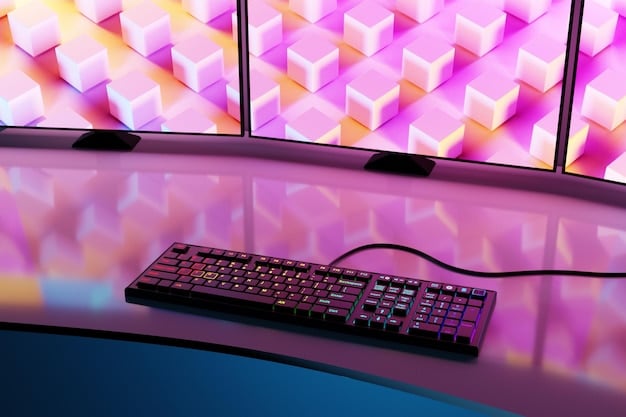
Conclusion
Identifying and addressing a CPU bottleneck is a crucial step for any PC gamer aiming for a truly optimized experience. By understanding the signs, utilizing diagnostic tools, and making informed upgrade choices, you can ensure that your system’s components work in harmony. As we move into 2025, a strategic upgrade to a balanced CPU and platform, coupled with diligent post-installation optimization, will undoubtedly elevate your gaming performance, providing smoother frame rates and a more immersive experience. The journey to a perfectly tuned gaming rig is continuous, but armed with the right knowledge, you are well-equipped to tackle the challenges and enjoy the fruits of your upgraded system.
